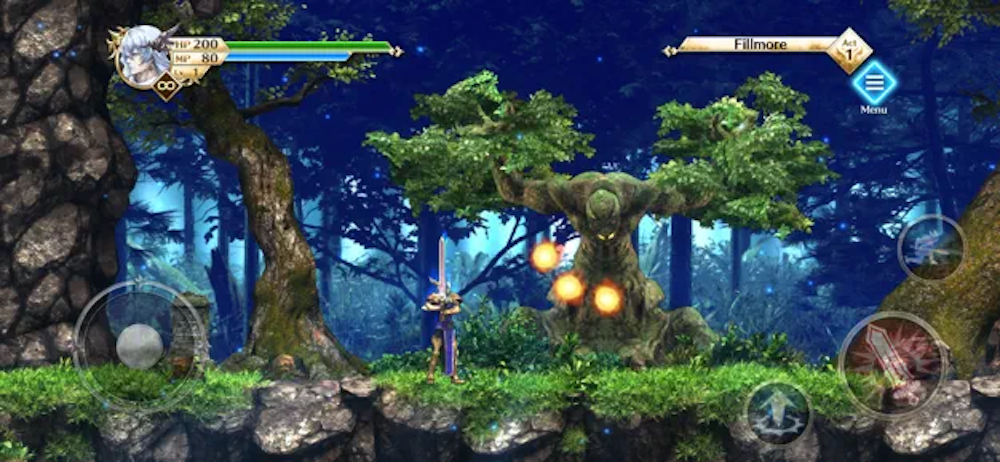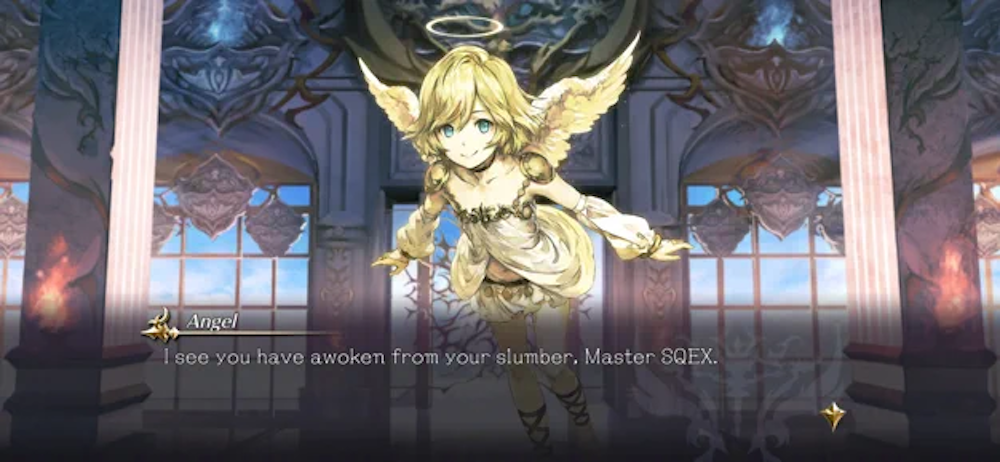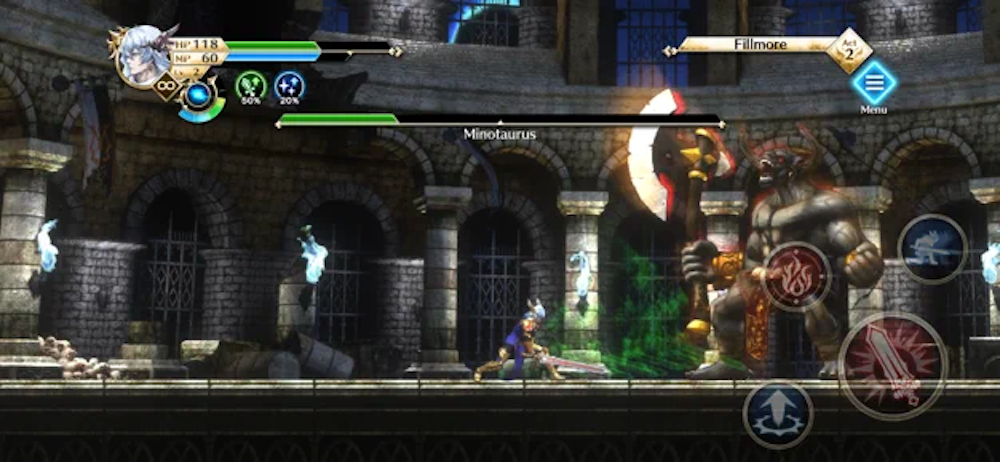 I never expected to see ActRaiser again. A memorable and successful early release for the 16-bit Super NES in North America, ActRaiser hasn’t had a lot of luck since then. It was followed up by an incredibly misguided sequel that seemingly killed the franchise. Then its developer, Quintet, faded out under mysterious circumstances, taking much of its IP with it. The game’s publisher, Enix, merged with Square and the new company appeared to have little interest in massive chunks of Enix’s historical output. ActRaiser got a Japan-only port of its action stages for feature phones, and a Virtual Console release early on in the Nintendo Wii’s life. And then there was silence.
I never expected to see ActRaiser again. A memorable and successful early release for the 16-bit Super NES in North America, ActRaiser hasn’t had a lot of luck since then. It was followed up by an incredibly misguided sequel that seemingly killed the franchise. Then its developer, Quintet, faded out under mysterious circumstances, taking much of its IP with it. The game’s publisher, Enix, merged with Square and the new company appeared to have little interest in massive chunks of Enix’s historical output. ActRaiser got a Japan-only port of its action stages for feature phones, and a Virtual Console release early on in the Nintendo Wii’s life. And then there was silence.
There’s a lot of talk about the legal status of Quintet’s library among fans of that developer that burned so brightly and briefly. Is it the case that Square Enix doesn’t want to rerelease the games? Or is it the case that Square Enix can’t? At least as it pertains to the original ActRaiser, that question was answered rather decisively a week ago. During one of Nintendo’s Direct presentations, some familiar music began to play. Wow, a remake of the original ActRaiser, and it’s out today? And not just on Nintendo Switch, but on pretty much everything including iOS? Neat. Very, very neat.

That was just the start of the Actraiser Renaissance ($19.99) roller coaster ride. Almost immediately after the initial excitement, people began to criticize its visuals. It has the look of a 2.5D PlayStation Portable game, nowhere near fully modern but also a far cry from the original game’s attractive pixel art. Ah, but Yuzo Koshiro was brought back to make new arrangements of the soundtrack, and they are as incredible as you would expect. But wait, who’s the developer? Sonic Powered? The airport and rail sim people? And wait, they changed some things? Why? Add in some slightly choppy scrolling in the action stages and some mixed feelings about the expanded simulation segments, and the first reports about this remake weren’t great. More bad luck, it seemed.
I’m not going to sit here and tell you Actraiser Renaissance is perfect. That choppy scrolling is certainly there, though better in the mobile version than in some others. I don’t think the game looks terrible, but it certainly isn’t going to impress many with its chosen art style. It’s certainly a much longer game, with some extensive changes to many of its systems, and for those who liked the snappy pace and simplicity of the original ActRaiser those could be deal-breaking. Specific to the mobile version, those playing without a controller are likely going to find the action stages a bit less enjoyable than they are with button controls. At least we have controller support in this release. Thank you for that, Square Enix.

So yes, not perfect. But I will say this, having played through the entire game two times on two different platforms in the last week: it’s a lot better than I would have expected. If you can set aside your ideas of how a remake of ActRaiser ought to be, I think you’ll find Actraiser Renaissance to be a bold, excellent take on the original game’s concept. This is a remake, but it’s not trying to be strictly faithful to every aspect of the original. It feels like the halfway point between a remake and a sequel, and in the latter respect I think it’s considerably more fascinating than the actual sequel.
ActRaiser was always an odd duck. You play as The Master, who is essentially the deity of the world. You’ve been asleep for a long time, and an evil force named Tanzra has taken hold of the world in that period. Humanity barely clings on against the monsters that roam the land. Now that you’re awake, you need to give the people a helping hand. Although you spend most of the game up in your Sky Palace, you can send your angel assistant to act as a liaison between you and your followers to help guide them and answer their prayers. You can also use your powers to generate miracles like rain, thunder, and more. And when it’s time to get a bit more hands-on with Tanzra’s legions, you can send your consciousness to a warrior statue that is quite capable of taking down even the biggest of beasts.

You could either consider it a side-scrolling action game with simulation segments between the stages, or a simulation game with side-scrolling action segments that pop up now and then. I wouldn’t argue much with either interpretation. That unique blend made the game stand out in a big way, even if neither side of the equation was best-in-class. It did both things well enough, and stylishly enough, that the game sat a brilliant, singular whole. But putting on the critical specs, you could say that the action scenes were a bit stiff and featured bosses that were too easy to cheese with magic. You could say that the simulation segments were a little too simplified for their own good. There was room to build on this game.
Actraiser Renaissance takes advantage of that space to grow. The action scenes have a better flow to them and are more exciting to play thanks to improved enemy behaviors and an expanded set of moves for The Master. Boss battles in particular are far more interesting. The stages are redesigned and expanded, and you’ll be engaging in brief action bits during the simulation segments as well when sealing enemy lairs. I don’t dislike the chunky and deliberate nature of the original game, and it can be fun to obliterate bosses with ease by spamming magic, but I’m also a big fan of the approach Renaissance has taken.

The simulation segments see far more extensive changes. There’s a lot more story, for one thing. They’re a lot longer as well. While the broad strokes are the same, one major new system has been added in that completely changes the nature of these portions of the game. You’ll still get occasional attacks from monsters spawning from the lairs that you’ll have to shoot down with your angelic assistant. But on top of that, you will sometimes have to defend from full-on invasions. During these segments, your angel can’t use its weapon. Instead, you have to build defenses as best as you can beforehand, direct the town’s hero character to fend off foes, and use your miracles when and where you can to help turn the tides. Oh yes, it’s tower defense, friends. And there’s a lot of it.
Most of the other changes in the simulation sections feed into that new system. Certain buildings will generate certain resources, and you’ll need them to build and upgrade towers, keep your heroes healed, regenerate SP so you can use more miracles, and place palisades. At first I wasn’t sure how I felt about all of this. I’m not a huge fan of tower defense games, so seeing this kind of gameplay take such a prominent stage in a remake of a game that had nothing of the sort felt odd. But in the end, I think it works. Thematically it makes sense that these towns would be getting attacked by Tanzra’s hordes. From a story standpoint, it helps weave the new heroes into the fleshed out tale. And in terms of gameplay, it’s a solid way to expand the complexity and value of the simulation segments. It now matters what and where your followers build. There are benefits to rebuilding with newer structures beyond simply raising the population. These are all good things, in my opinion.
I certainly can’t deny that it makes for a very different game, however. This is not the kind of remake most video game fans will be accustomed to, I think. And when such radical remakes have happened, they’ve gone wrong often enough to have people suspicious of the whole idea. But I look at what we have here in Actraiser Renaissance and I not only appreciate its value as a game, but also as an idea for how this series could move forward. I will always enjoy the original game, but I can’t imagine a brand-new, full-priced game that adheres to its specifics. I can easily imagine one that follows on from Actraiser Renaissance. One that improves on its new ideas, builds on them, and keeps on growing. The key to an ActRaiser sequel was never to subtract, but to add. And that’s what this game does, even if it’s not strictly speaking a sequel.
If you’re looking for a carbon copy of the original game with an improved presentation and nothing else of significance added, I’m afraid you may not like Actraiser Renaissance. This isn’t that kind of remake, and I personally don’t think it should have been. But if you’re fine with something with the flavor of ActRaiser, with the essence of the original but also a personality of its own, I think you will like this game. It has its flaws, particularly in its visual presentation, and some of its new ideas could use a bit more hammering out. But it, like the game it is based on, is a rather unique game that pulls you in powerfully the more time you spend with it. There isn’t a whole lot like this out there, and it’s handily better than other homages like SolSeraph. And hey, that incredible music sure doesn’t hurt.